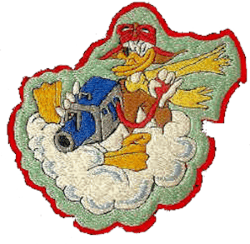681st Bombardment Squadron
| 681st Bombardment Squadron | |
|---|---|
|
26th Photo Reconnaissance Squadron Patch | |
| Active | 1943-1946; 1947-1949; 1955-1962; 1993- |
| Country |
|
| Branch |
|
| Role | Intelligence |
| Engagements | South West Pacific Theater of World War II |
| Decorations |
Distinguished Unit Citation Air Force Outstanding Unit Award Philippine Republic Presidential Unit Citation |
The 681st Bombardment Squadron is an inactive United States Air Force unit. It was last assigned to the 70th Bombardment Wing. It was last stationed at Little Rock Air Force Base, Arkansas, and was inactivated on 25 June 1962.
History
Established in early 1943 as the 26th Photographic Reconnaissance Squadron, trained under Second Air Force. Deployed to Fifth Air Force in the Southwest Pacific Area (SWPA), initially to Australia, then flying long range unarmed combat aerial photography missions during the New Guinea Campaign from forward airfields in Papua New Guinea with photographic versions of the P-38 Lightning. Moved forward to support Mac Arthur's island hopping campaign to the Netherlands East Indies, then flying missions in support of the 1944-1945 Philippines Campaign. Later moving to Okinawa in August 1945 after the Japanese Capitulation. Flew aerial reconnaissance over Occupied Japan and Korea, inactivating in early 1946.
Reactivated in 1947 in the reserve at Hamilton Field, California, but it is unclear whether or not the unit had any assigned aircraft of personnel. It was inactivated in 1949 due to budgetary reductions.
Reactivated under Strategic Air Command in 1955 as a RB-47 Stratojet reconnaissance squadron flying strategic reconnaissance missions to meet SAC's global reconnaissance commitments from October 1955 – 1962. Flew many long-range clandestine missions with the RB-47, flying many ferret missions around the periphery of Soviet territory, and sometimes inside on penetration flights to map planned routes for B-52s if combat missions over the Soviet Union ever became necessary. Missions flown on a reduced scale after February 1958 when events showed the vulnerability of the RB-47 to Soviet air defenses and the development of the U-2 aircraft. Converted to standard B-47 medium bombers in late 1961 and redesignated as 681st Bombardment Squadron, but inactivated in 1962 prior to becoming combat ready.
Lineage
- Constituted as the 26th Photographic Reconnaissance Squadron on 5 February 1943
- Redesignated 26th Photographic Squadron (Light) on 6 February 1943
- Activated on 9 February 1943
- Redesignated 26th Photographic Reconnaissance Squadron on 11 August 1943
- Inactivated on 20 Feb 1946
- Redesignated 26th Reconnaissance Squadron, Very Long Range (Photographic-RCM) on 3 Ju1y 1947
- Activated in the reserve on 1 August 1947
- Inactivated on 27 June 1949
- Redesignated 26th Strategic Reconnaissance Squadron, Medium on 14 Jan 1955
- Activated on 24 Jan 1955
- Redesignated 681st Bombardment Squadron, Medium on 25 Oct 1961.
- Discontinued and inactivated, on 25 Jun 1962
- Redesignated 26th Intelligence Squadron
- Activated ca. 30 April 1993
- Redesignated 26th Air and Space Intelligence Squadron unknown
- Inactivated 6 October 2006
Assignments
- 6th Photographic (later Photographic Reconnaissance and Mapping; Photographic Reconnaissance; Photographic; Reconnaissance) Group, 9 Feb 1943 (attached to 308th Bombardment Wing after 22 Oct 1945)
- 308th Bombardment Wing, 21 Nov 1945-20 Feb 1946
- 70th Reconnaissance Group, 1 Aug 1947-27 Jun 1949
- 70th Strategic Reconnaissance (later Bombardment) Wing, 24 Jan 1955-25 Jun 1962
- Unknown ca 1993
- 502d Air Operations Group, 27 October 2000 - 6 October 2006
Stations
- Peterson Field, Colorado, 9 February 1943 - 22 October 1943
- Sydney Airport, Australia, 19 November 1943
- Archerfield Airport, Australia, 25 Nov 1943
- Dobodura Airfield Complex, New Guinea, 26 Jan 1944 (detachment at Port Moresby Airfield Complex, New Guinea, February 1944 - March 1944
- Finschafen Airfield, New Guinea, 19 Feb 1944
- Nadzab Airfield Complex, New Guinea, 28 Mar 1944 (air echelon at Hollandia Airfield Complex, New Guinea, after 25 Jun 1944)
- Hollandia Airfield Complex, New Guinea, 23 Ju1 1944
- Mokmer Airfield, Biak, Netherlands East Indies, 5 Aug 1944
- Lingayen Airfield, Luzon, Philippines, 16 Jan 1945 (air echelon at Clark Field, Luzon, Philippines, 22 Jul-Sep 1945)
- Kadena Airfield, Okinawa, 6 Aug 1945
- Kimpo Airfield, Korea, Oct 1945-20 Feb 1946
- Hamilton Field, California, 1 Aug 1947-27 Jun 1949
- Little Rock AFB, Arkansas, 24 Jan 1955-25 Jun 1962
- Hickam Air Force Base, Hawaii, ca. 30 October 1993 - 6 October 2006
Aircraft
- F-4 Lightning, 1943
- F-5 Lightning, 1944-1946.
- RB-47 Stratojet, 1955-1961
- B-47 Stratojet, 1961-1962.
References
Notes
Bibliography
![]() This article incorporates public domain material from the Air Force Historical Research Agency website http://www.afhra.af.mil/.
This article incorporates public domain material from the Air Force Historical Research Agency website http://www.afhra.af.mil/.
- Maurer, Maurer, ed. (1982) [1969]. Combat Squadrons of the Air Force, World War II (PDF) (reprint ed.). Washington, DC: Office of Air Force History. ISBN 0-405-12194-6. LCCN 70605402. OCLC 72556.

